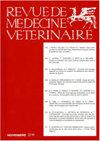Q2 Veterinary
引用次数: 9
摘要
益生菌和益生元目前被认为是亚治疗抗生素作为生长促进剂的潜在替代品。这样做的好处是,这些药剂不会在禽蛋或禽肉中留下残留物,也不会导致人类微生物群产生抗生素耐药性的风险。在家禽饲养中使用益生菌微生物,主要是产乳酸菌,有助于维持肠道菌群的完整性和稳定性。这阻碍了有害微生物的繁殖,从而有助于预防疾病的发生并提高生产性能。然而,关于它们作为生长促进剂的作用,结果是相互矛盾的,主要是因为微生物的多样性和可以施用的剂量,所使用的家禽类型,施用方法,饲料组成和进行生物测定的环境条件。因此,鉴于需要消除抗生素作为生长促进剂,有必要继续研究和扩大我们对这些添加剂的知识,通过进行生物测定来确定细菌菌株和集约化生产下现代家禽谱系中最合适的给药方法。这篇综述的目的是对这些物质起作用的条件进行分析,并解释为什么它们的影响有时微不足道。本文章由计算机程序翻译,如有差异,请以英文原文为准。
Probióticos en la avicultura: una revisión
Probiotics and prebiotics are currently postulated as a potential replacement alternative to sub-therapeutic antibiotics as growth promoters. The advantage is that these agents do not leave residues in the egg or meat of the poultry, and do not cause risk of developing antibiotic resistance in human microbiota. The use of probiotic microorganisms, mainly lactic acid-producing bacteria in poultry feeding, contributes to maintaining the integrity and stability of the intestinal flora. This hampers the proliferation of harmful microorganisms, which helps to prevent the onset of disease and improves productive performance. Nevertheless, regarding their effect as growth promoters, results are contradictory, largely because of the variety of microorganisms and doses that can be administered, the type of poultry used, methods of administration, diet compositions, and environmental conditions in which bioassays are performed. Therefore, given the need to eliminate antibiotics as growth promoters, it is essential to continue researching and expanding our knowledge of these additives, by conducting bioassays to determine bacterial strains and the most suitable methods of administration in modern poultry lineages under intensive production. The objective of this review is to present an analysis of the conditions under which these substances work, and to explain why their effects are sometimes insignificant.
求助全文
通过发布文献求助,成功后即可免费获取论文全文。
去求助
来源期刊

Revue De Medecine Veterinaire
农林科学-兽医学
CiteScore
1.30
自引率
0.00%
发文量
0
审稿时长
18-36 weeks
期刊介绍:
The Revue de Médecine Vétérinaire publishes four kinds of text:
1) Scientific reviews on subjects related to veterinary and comparative medicine. Suggested length: 10 to 30 typed pages.
2) Original reports on fundamental or applied research. Suggested length: 10 to 15 typed pages.
3) Continuous education articles, that should be easily understandable by non-specialists. Suggested length: 10 to 15 typed pages.
4) Clinical reports. Suggested length: 5 to 15 typed pages.
The publication can be done in French language or English language.
For an article written in English by not english native speakers authors, the manuscript must be subjected by attesting that it was read again by an anglophone scientist or a scientific translator.
The authors must certify that the manuscript was not published or subjected for publication to another review.
The manuscript must be accompanied by a sheet signed by all the joint authors indicating their agreement for the tender of the manuscript.
The publication is free but a financial participation could be required for the photographs color. An estimate will be sent to collect the agreement of the authors.
 求助内容:
求助内容: 应助结果提醒方式:
应助结果提醒方式:


